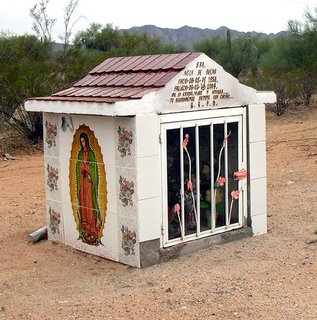 Arizona desert landscape along the sides of the road. These public shrines, also called capillitas or grutas, have become Southwestern cultural icons. Part folk art and part expression of faith, they have evolved from the Spanish-Catholic traditions brought to the New World by early missionaries and settlers. Many mark the sites of fatal auto accidents and similar tragedies.
Arizona desert landscape along the sides of the road. These public shrines, also called capillitas or grutas, have become Southwestern cultural icons. Part folk art and part expression of faith, they have evolved from the Spanish-Catholic traditions brought to the New World by early missionaries and settlers. Many mark the sites of fatal auto accidents and similar tragedies. On a recent road trip from Why, Arizona into Mexico, I could not help but notice the beauty of those shrines in the desert.
On a recent road trip from Why, Arizona into Mexico, I could not help but notice the beauty of those shrines in the desert..
.
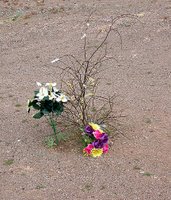
.
They ranged from the very simple to very elaborate and exhibit a tragic beauty of faith in folkart.
.
.
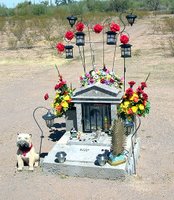 Some of the shrines are simple crosses on the edge of the road, while others are more elaborate with candles, statues, artificial flowers surrounded by carefully raked sand.
Some of the shrines are simple crosses on the edge of the road, while others are more elaborate with candles, statues, artificial flowers surrounded by carefully raked sand..
.
.
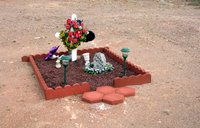
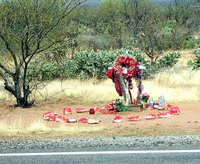 The straight flat highway through the Tohono O'odham Reservation is very monotonous. I noticed the shrines to others who also found it monotonous, and died along its straight shoulders. They appeared different from the ones I had seen before.
The straight flat highway through the Tohono O'odham Reservation is very monotonous. I noticed the shrines to others who also found it monotonous, and died along its straight shoulders. They appeared different from the ones I had seen before..
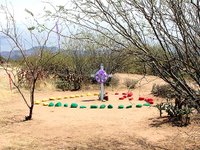 The Tohono O'odham tribe is one of the few North American tribes never removed or relocated from its ancestral land. Once known as the Papago, the tribe officially changed its name to Tohono O'odham in 1986: "the Desert People Who Have Emerged from the Earth". Some archaeologists believe the O'odham are direct descendants of the Hohokam, who moved into the area about AD 200.
The Tohono O'odham tribe is one of the few North American tribes never removed or relocated from its ancestral land. Once known as the Papago, the tribe officially changed its name to Tohono O'odham in 1986: "the Desert People Who Have Emerged from the Earth". Some archaeologists believe the O'odham are direct descendants of the Hohokam, who moved into the area about AD 200.

It's interesting to see the differences in culture from region to region. In the Telegraph this morning, there was a piece about a roadside shrine a woman had placed where her daughter died in a car accident in Windham.
ReplyDeleteThe official policy is to allow these things for six months, but that's usually overlooked. In this case, however, the woman constantly visits and adds even more items to the shrine. It's grown to include four crosses now, and a giant Easter bunny, among many other items. Windham police are saying it's getting to be a nuisance and distraction, and being past the six months, must come down now. The woman protests that visiting it helps her with her grief.
I get the impression that in Arizona such a shrine would be accepted as part of the culture, and would not be disturbed.
Then again, the shrines you photographed look like works of art, rather than miscellaneous collections of a mother's grief. Many roadside shrines here in New Hampshire wind up looking like little piles of trash.
Cultural differences probably dictate a more thoughtful approach to the design of the shrines. Obviously, in AZ those who build them know they're more accepted - and they have often built more durable, attractive structures.
Oh my gosh I was in rocky point for spring break!!! It was such a beautiful place we really enjoyed ourselves. i recognized the shrines in your post and read further then read part of your previoyus post. I'm on the bead crochet yahoo group too.
ReplyDelete